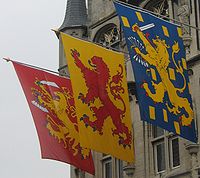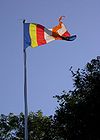Portal:Heraldry
Welcome to the Heraldry and Vexillology Portal!


Vexillology (from the Latin vexillum, a flag or banner) is the scholarly study of flags, including the creation and development of a body of knowledge about flags of all types, their forms and functions, and of scientific theories and principles based on that knowledge. Flags were originally used to assist military coordination on the battlefield, and have evolved into a general tool for signalling and identification, particularly identification of countries.
Heraldry encompasses all of the duties of a herald, including the science and art of designing, displaying, describing and recording coats of arms and badges, as well as the formal ceremonies and laws that regulate the use and inheritance of arms. The origins of heraldry lie in the medieval need to distinguish participants in battles or jousts, whose faces were hidden by steel helmets.
Selected biography

Elias Ashmole was an antiquarian, collector, politician and officer of arms. He supported the royalist side during the English Civil War, and at the restoration of Charles II he was rewarded with several lucrative offices, including Windsor Herald of Arms in Ordinary. Throughout his life he was an avid collector of curiosities and other artifacts. Many of these he acquired from the traveller, botanist, and collector John Tradescant the elder and his son of the same name, and most he donated to Oxford University to create the Ashmolean Museum. He also donated his library and priceless manuscript collection to Oxford. Apart from his collecting activities, Ashmole illustrates the passing of the pre-scientific world view in the seventeenth century: while he immersed himself in alchemical, magical and astrological studies and was consulted on astrological questions by Charles II and his court, these studies were essentially backward-looking. Although he was one of the founding members of the Royal Society, a key institution in the development of experimental science, he never participated actively. (more...)
Selected flag

The flag of the People's Republic of China is a red field charged in the canton (upper left corner) with five golden stars. The design features one large star, with four smaller stars in a semicircle set off towards the fly (right side). The red represents revolution; the five stars and their relationship represent the unity of the Chinese people under the leadership of the Communist Party of China (CPC). Sometimes, the flag is referred to as the "Five Star Red Flag" (simplified Chinese: 五星红旗; traditional Chinese: 五星紅旗; pinyin: wǔ xīng hóng qí).
The flag was designed in response to a circular distributed by the Preparatory Committee of the New Political Consultative Conference (新政治協商會議籌備會) in July 1949, shortly after they came to power following the Chinese Civil War. About three thousand entries were received for the design competition, and after slight modifications, the design by Zeng Liansong, a citizen from Rui'an, Zhejiang, was chosen as the national flag. The construction sheet for the national flag was published on September 28, 1949 by an order from the Presidium of the First Plenary Session of the Chinese People's Political Consultative Conference. The first flag was hoisted by Mao Zedong on a pole overlooking Beijing's Tiananmen Square on October 1, 1949, at a ceremony announcing the founding of the People's Republic. (more...)
Selected coat of arms

The coat of arms of Slovakia is composed of a silver (argent) double cross, elevated on the middle peak of a dark blue mountain consisting of three peaks. It is situated on a red (gules) early gothic shield. Extremities of the cross are amplificated, and its ends are concaved. The same symbol (with other colours and minor changes) is in the sinister portion of the Hungarian coat of arms. (more...)
Selected picture

The town hall of Gouda, a city in the Netherlands, displaying heraldic banners of the arms of (left to right) the Dutch Republic (1581–1795), the County of Holland (1198–) and the Kingdom of the Netherlands (1815–).
Did you know...
- ...that Migettuwatte Gunananda Thera once served on the committee that designed the Buddhist flag (pictured) in 1885?
- ...that the seals of the graduate schools of Harvard University were designed by Pierre de Chaignon la Rose?
- ...that the horseman depicted on the coat of arms of Moscow was not identified with Saint George until the 18th century?
- ...that the United Nations Honour Flag was designed as a symbol of the Allies of World War II at the suggestion of Winston Churchill?
- ...that in 1865, William Carpenter Bompas protected his party of ox-carts from attacks by purportedly hostile Sioux by flying the Flag of England?
Related portals
|
|
|
Heraldry Web resources
Authorities
- Belgium - The Council of Nobility, Flemish Heraldic Council and Council of Heraldry and Vexillology of the French Community
- Canada - Canadian Heraldic Authority and see also Public Register of Arms, Flags and Badges
- England, Wales, and Northern Ireland - The College of Arms
- Ireland - The Office of the Chief Herald of Ireland
- Netherlands - High Council of Nobility
- Portugal - Instituto da Nobreza Portuguesa
- Scotland - The Court of the Lord Lyon
- South Africa - South African Bureau of Heraldry
- Sweden - National Board of Heraldry, The National Archive
- United States Army - The United States Army Institute of Heraldry
Societies
- Greek Heraldry Society
- The Academy of Heraldic Science Czech republic
- The American College of Heraldry
- The American Heraldry Society
- The Augustan Society
- The Australian Heraldry Society Inc.
- Bulgarian Heraldry and Vexillology Society
- The Center for Research of Orthodox Monarchism
- Cambridge University Heraldic and Genealogical Society
- Chiltern Heraldry Group
- The College of Dracology
- Croatian Heraldic and Vexillologic Association
- The Finnish Heraldic Society
- Fryske Rie foar Heraldyk
- Hellenic Armigers Society
- Guild of Heraldic Artists
- Genealogical Society of Ireland
- Heraldry Research Institute (Japan)
- The Heraldry Society
- The Heraldry Society of Africa
- The Heraldry Society of New Zealand Inc.
- The Heraldry Society of Scotland
- The Heraldry Society of Southern Africa
- The Institute of Heraldic and Genealogical Studies
- The International Association of Amateur Heralds
- Italian Center of Vexillological Studies
- Lancashire Heraldry Group
- Macedonian Heraldry Society
- New England Historic Genealogical Society Committee on Heraldry
- Norwegian Heraldry Society
- Oxford University Heraldry Society
- Polish Heraldry Society
- Polish Nobility Confederation
- Real Academia Matritense de Heráldica y Genealogía - Royal Academy of Heraldry and Genealogy of Madrid
- Romanian Institute for Genealogy and Heraldry
- The Royal Heraldry Society of Canada
- The Russian College of HeraldryThe Russian College of Heraldry
- Serbian Heraldic Society
- Societas Heraldica Scandinavica
- Societas Heraldica Slovenica
- Swedish Heraldic Society
- Ukrainian Heraldry Society
- Royal Association Genealogical and Heraldic Office of Belgium
Vexillology
Software
- Coat of Arms Visual Designer web-based program
- Puncher Heraldry Program
- Blazonry Server - pyBlazon
- DrawShield - creates SVG shield or arms image from blazon
- CoaMaker - web-based tool
- Blazon95 and BLAZONS! 2000, older Windows applications
- Heraldicon
Texts
- Heraldry, historical and popular : with seven hundred illustrations (1863)
- A Complete Guide to Heraldry (1909)
Other
Wikimedia
The following Wikimedia Foundation sister projects provide more on this subject:
-
Commons
Free media repository -
Wikibooks
Free textbooks and manuals -
Wikidata
Free knowledge base -
Wikinews
Free-content news -
Wikiquote
Collection of quotations -
Wikisource
Free-content library -
Wikispecies
Directory of species -
Wikiversity
Free learning tools -
Wikivoyage
Free travel guide -
Wiktionary
Dictionary and thesaurus












